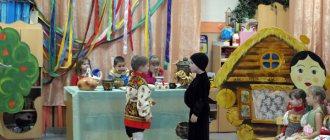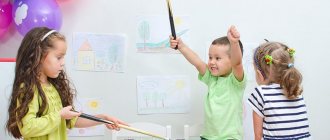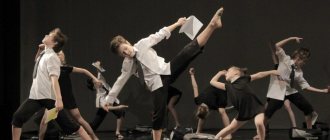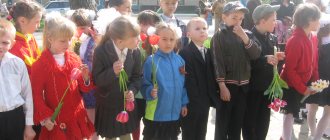MAGAZINE Preschooler.RF
Consultation for teachers “Organization of work with gifted children in preschool educational institutions”Khanty-Mansiysk Autonomous Okrug-Ugra Oktyabrsky district village settlement Unyugan Municipal budgetary preschool educational institution "Kindergarten of general developmental type "Fairy Tale"
The material was prepared and implemented by: Oksana Vasilievna Klyueva, educational psychologist 2021
“There are invisible strings in the soul of every child. If you touch them with a skillful hand, they will sound beautiful . V.A. Sukhomlinsky
Children's talent is one of the most mysterious phenomena of nature, arousing increased interest and admiration from others. Society needs people with extraordinary thinking and a creative approach who can make a valuable contribution to the development of humanity. Therefore, a child with a high level of development and cognitive activity requires special attention from preschool teachers.
A gifted child is noticeably different from most of his peers in his special curiosity: he shows increased attention to the world around him, quickly answers the teacher’s questions, experiments with objects, composes and tells fairy tales and unusual stories, is interested in playing with construction sets, asks many questions and has a large vocabulary. A child’s abilities are always manifested in activity, and can only be revealed in specific activities, the process of which gives the child pleasure - music, drawing, mathematics and other fields.
In this regard, teachers must organize the educational process in such a way as to identify children with creative and innovative thinking, support and develop their abilities within the framework of preschool education. To do this, preschool teachers need to conduct an initial diagnosis and subsequent examinations. Analysis of the results of the research helps in applying a differentiated approach to education, identifying gifted children and assessing the quality of the teaching methods used. Based on the results, the level of development of the preschooler is determined.
Gifted children in preschool educational institutions: areas of child giftedness
Each child with increased mental abilities is individual, with his own interests and preferences, with a craving for a certain type of activity. The following areas of a child’s giftedness are distinguished:
- Intellectual sphere: the child is distinguished by sharp thinking, excellent memory and special attentiveness, shows curiosity and increased interest in learning, competently expresses thoughts and ideas
- Academic sphere: the child has a strong desire to read, has an extensive vocabulary, excellent understanding of the material and its assimilation; the child shows interest in mathematical tasks and easily performs calculations
- Creative sphere: the child is highly productive and inventive in educational and gaming activities, generates original ideas and has his own ideas, can apply different approaches to assigned tasks
- Communication sphere: the child is self-confident, easily finds a common language with others, takes initiative in communicating with peers, takes responsibility in making decisions, shows leadership qualities
- Artistic sphere: the child shows interest in visual sources of information, is interested in drawing and modeling, his creativity is original
- Musical area: the child shows interest in musical activities, reacts sensitively to musical works, and is able to produce short rhythmic passages
- Physical: The child enjoys physical activity, performs tasks that require fine and precise motor skills, and has good hand-eye coordination.
The tasks of a preschool teacher in teaching gifted children
Based on the requirements for creating favorable conditions for teaching gifted children, preschool teachers must have a developed training program.
The goals of the program are to identify, support and develop children with increased intellectual abilities. Gifted children need an individual education program, which is why preschool teachers must undergo special professional training.
When working with gifted preschoolers, preschool teachers are recommended to use innovative pedagogical technologies, improve the scientific and methodological base, collaborate with children's public organizations and exchange experience with other teachers at the municipal and regional level. The teacher must have a high psychological level to work with gifted children, without putting pressure on the child if he wants to do something his own way and is unable to follow accepted norms. Preschool teachers should be more attentive to gifted students so that children feel needed and in demand. It is necessary to increase the child’s mental load by introducing interesting facts and integrated tasks and games, thereby encouraging and developing the child’s cognitive activity. Stimulation of the preschooler is also important: honor boards, intellectual games and competitions, awards. At the slightest failure, self-esteem drops sharply, since a gifted child has increased demands on himself and a desire for perfectionism. But upon achieving a certain success, the self-esteem of a gifted child increases to such an extent that it develops into superiority over others. Preschool teachers should pay attention to the psychological characteristics of a gifted child and help him develop social and communication skills and build relationships with peers, as well as adults.
Project method in teaching gifted children in preschool educational institutions
Gifted children need exploratory activities that allow them to immerse themselves in creative learning, develop a thirst for knowledge, and strive for discovery and self-knowledge. The project method used in the classroom is ideal for realizing the cognitive interest of preschoolers and developing their creative and mental abilities. Taking into account the level of giftedness and the range of interests, the child is asked to complete a project: through research, find a solution to the problem and summarize the results, expressing his point of view to the public. This form of education provides a gifted child with the opportunity to study with peers and be in a familiar social environment, while expanding their abilities and enriching their knowledge. When completing project tasks, the teacher plays the role of a consultant, helps and supports the child in completing tasks. After all, the main task of the teacher is to help the child manifest and develop his abilities.
Experienced preschool specialists use four main teaching strategies when working with gifted children:
- "Acceleration" strategy . Takes into account the needs of children with an accelerated pace of development
- Strategy "Deepening" . For children with increased interest in a certain area of activity, it provides for in-depth study of the subject
- Strategy "Enrichment" . Organizing basic educational and gaming activities in such a way that children have additional time to pursue their hobbies
- Strategy "Problematization" . Stimulating the personal development of preschool children by searching for non-standard and alternative explanations and revising existing information. Often this strategy is not used independently and is part of the “Enrichment” or special educational programs.
Organization of work with gifted children in preschool educational institutions
How to identify gifted children. To identify gifted children, it is necessary to conduct a diagnosis and fill out a gifted child card.
To do this, use the observation method, study their psychological characteristics, speech, memory, thinking. Gifted children have higher intellectual abilities, receptivity to learning, and creative abilities than other children. Cognitive activity dominates in them. They experience joy from acquiring knowledge and from mental work.
What mistake to avoid. The teacher’s task is not to identify who is more gifted and who is less. You need to provide opportunities for the development of children with different talents.
What are the categories of gifted children?
- Children with accelerated mental development. They stand out sharply for their high level of intelligence. Such children will be especially noticeable in primary school. They have a pronounced cognitive activity.
- Children who have generally normal intelligence, but have a special affinity for a particular field of science or technology.
- Children with individual signs of extraordinary abilities. They are not ahead of their peers in the general development of intelligence and do not show remarkable success, but they may have extraordinary memory, a rich imagination, or special powers of observation that have not yet found application.
What are the age-related characteristics of the manifestation of cognitive activity?
Early age (up to 3 years):
- exploratory search activity;
- sensitivity, or sensitivity, to the novelty of a stimulus;
- the ability to discover something new in the ordinary;
- high curiosity.
Junior and middle preschool age (3–5 years):
- raising questions and problems independently;
- research and an inquisitive mind;
- identifying relationships, causes and effects.
Senior preschool age (6–7 years):
- problematic;
- openness to new things;
- search for inconsistencies and contradictions.
Giftedness presupposes flexibility of thinking. This is a property of creative thinking, thanks to which a child can vary the ways of solving problems. Flexibility of thinking can begin to be developed in children from the age of 4. At the age of 5–6, this skill is actively developing, but in order for this process to continue, attention must be paid to it. If you use ready-made templates for solving problems in classes with children, then creative abilities will not develop.
What are the techniques for developing creative thinking?
1. Combinatorial tasks: “In how many ways can you make a four-color flag from horizontal stripes if you have four different colors” ?
Such tasks can be proposed when children have already developed the concepts of “some” , “each” , “part” , “whole” , “set” , “elements of a set” , etc.
2. Tasks on identifying various features of objects: “What are the similarities and differences between the objects “table” and “chair”?” , “What can you say about watermelon?” , “What is white and fluffy?” .
3. Practical tasks for making figures from sticks: “Build five squares, using six sticks .
4. Getting to know tables and diagrams: “Which figure should be placed in an empty cell?” .
5. Exercises for the development of creative abilities in children: “Name as many options for using an ordinary sheet of paper as possible” , “Complete 10 identical circles, turning them into various pictures” , “Select definitions for various words” , “Game “What do they have in common?” ”” , “Exercise “What can be made from?...”” , “Task “Invent and depict”” , “Create fairy tales on a certain topic, modification of fairy tales, etc.” , “The Game “Good-Bad”” , “What could it be?” .
What qualities does a teacher need to develop creative abilities in children?
- Personal: positive self-concept, determination, maturity - clear awareness of one’s goals and objectives, emotional stability, sensitivity.
- Professional: knowledge and skills that help in the development of each child. Knowledge and skills that contribute to the development of general and special talents in children. Ability to identify gifted children; choose the optimal forms of training for them; develop and individualize educational programs, evaluate the effectiveness of training, advise gifted children and their parents.
- Behavioral: listening skills, creating a favorable atmosphere, using questioning techniques. At the level of interpersonal relationships: the teacher receives satisfaction from communicating with children as interesting people and allows himself to be taught.
Recommendations for teachers and parents on raising gifted children:
- Help the child make independent decisions, without direct instructions or instructions
- Encourage expressions of initiative and interest
- Use the difficulties that have arisen as an area to apply previously acquired skills
- Help your child acquire knowledge and manage skills
- Support the child in adapting to the social environment of the preschool educational institution
Adults who are surrounded by a gifted child must have a stable psyche, since excessive emotional delight or, conversely, distrust towards the child can lead to a halt in the development of abilities. Preschool teachers should conduct regular consultation conversations with parents, helping them better understand their child and realize his potential.
The work of a preschool teacher with gifted children means constant development, personal growth, replenishment of knowledge in the field of psychology and means of teaching gifted children, exchange of experience with other teachers and educational psychologists, as well as close communication with parents of gifted students. Teachers and parents must unite in creating and maintaining favorable conditions for the development and embodiment of the creative potential of gifted children.
In other words, it is necessary to emphasize that it is necessary to prepare fertile soil for all children without exception, that is, to maximally develop the skills, abilities, cognitive and creative abilities of children. A gifted child needs a gifted teacher.
Talents are difficult to recognize, not everyone can believe in them. Talents must be nurtured, they must be developed, they must be believed in.
Anyone who is understanding can recognize a simple truth: Talents can be nurtured by a Mentor if he himself is talented
| Next > |
One of the biggest problems we have noticed is the problem of children communicating.
Often they did not hear each other, did not hear the good ideas being proposed. We tried to solve the problem individually, without relying on the help of a friend. Although the same Yura A. insistently repeated: “Listen to the opinion of others!”
Egocentrism and inability to work in a team are one of the characteristics of gifted children. And yet, such activities in a playful way are necessary for developing the talent of children, since they can not only develop their extraordinary abilities, but also help them adapt to society, teach them (albeit not immediately) to work in a team, listen and hear other people’s opinions.
Tasks:
Develop:
- the ability of children to consciously act in new conditions (set a goal, take into account conditions, carry out basic planning, get results);
- ability to act on one's own initiative;
- the ability to complete tasks without seeking help or adult supervision;
- the ability to carry out basic self-control and self-assessment of performance results;
- the ability to transfer previously acquired knowledge and actions to new conditions;
- ability to analyze and process received information in accordance with input data;
- research skills;
- creative thinking - the ability to find non-standard solutions and think beyond ready-made templates.
Pin:
- counting skills;
- the ability to correlate numbers with the number of objects;
- orientation skills according to the terrain plan.
Shape:
- ability and skills to work in a team;
- the ability to defend one’s point of view, listening to the opinions of others;
- the ability to take criticism constructively and admit your mistakes.
Bring up:
- responsibility to friends when doing your part of the work;
- sense of camaraderie (support the team in all situations, do not distance yourself from the team decision even if it is ineffective);
- respect and tolerance for the opinions of other team members.
The form of delivery is “lesson without a teacher.”
Progress of the lesson
The teacher invites the children to “launch a rocket into space,” and to do this they need to complete several tasks independently, without the help of adults. For each correctly completed task, you will be given some elements that will help launch the rocket. The teacher reminds the children that they can complete tasks only if they act together and listen to the opinions of others. Please note that as the game progresses, sound signals will sound, indicating to players that they are going in the wrong direction and need to look for another way to solve the problem. (Sound signals are necessary, as this allows children to get a little guidance in the decision options and not mark time.)
Task No. 1 - “Jug with a secret.”
A jug with a rubber ball at the bottom is offered. On the jug there are signs “Do not turn over” and “Do not remove from the bottom by hand.” To get the ball (and the number “1” is attached to it), children must figure out how to pour water into the jug and the ball will float up.
Cups of water are on the table. To allow experimentation, there are cups with different fillings.
Task No. 2 - “Pyramid”.
A disassembled pyramid is offered, which must be assembled according to the diagram lying nearby. Having assembled the pyramid, children also receive the numbers “4” and “10”.
Task No. 3 - “Group Plan”.
On the group plan, in certain places, the numbers of toys are indicated that need to be placed in these places. Toys with numbers stand nearby on the table. After completing the task correctly, players receive the numbers “0” and “9”.
Task No. 4 - “Entrance to the cosmodrome.”
It is expected that at the “gate to the cosmodrome” the children will place circles with drawn arrows in the empty spaces in the direction indicated on the fence next to the gate. Having opened the gate, the guys receive the number “3”.
Task No. 5 - “Launch code”.
Table 3/3 is suggested. In the top row there are images of the month, star, planet. There are 5 months, 8 stars, 6 planets and numbers from 0 to 9 on the table. Children are expected to count the months, stars, planets and put the corresponding numbers “5”, “8”, “6” in the table. This is the startup code. Having solved the code, players receive the numbers “5”, “8” and “6”.
Task No. 6 - “Ready to start.”
Cut letters of two colors are offered, from which words are assembled: red - “rocket”, blue - “start”. After completing the task correctly, players receive the numbers “2” and “7”. If the kids collect all the numbers from 0 to 10, they can count backwards to “launch a rocket into space.”
Materials:
- drawn rocket;
- sets of numbers from 0 to 10;
- pyramid, pyramid construction schemes;
- code table;
- handouts (planets, stars, months);
- a jug with a rubber ball and signs “Do not turn over” and “Do not remove from the bottom by hand”;
- cups with different fillings (two or three contain granulated sugar, others contain salt, three or four contain water);
- plan of a group room, toys with numbers stuck on them;
- painted gate with a lock;
- split letters;
- tambourine.




